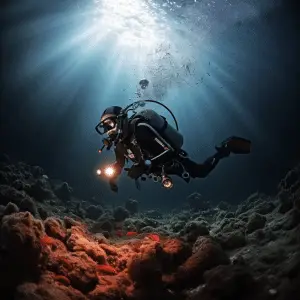Scuba diving takes us to a mesmerizing underwater world. But it can be dangerous. “The bends” is a life-threatening condition. It’s formally known as decompression sickness (DCS). It happens when divers ascend too fast. Nitrogen bubbles form in their tissues and cause pain. It can even damage organs.
So, understanding DCS is important for divers. It happens when they don’t follow ascent protocols. The nitrogen bubbles block blood flow and cause pain in joints and muscles. They can also affect vital organs.
To avoid the bends, divers must obey guidelines for safe ascent rates and diving profiles. They should monitor dive computers or tables carefully. Plus, certain factors can increase risks. Such as depth, time underwater, repetitive dives, cold temperatures, and dehydration. Knowing these can help them take precautions.
Thankfully, there’s a treatment. Hyperbaric chambers help dissolve the nitrogen bubbles. They subject patients to higher-than-normal atmosphere pressures. This breakthrough has revolutionized diving medicine!
What are “the bends” in scuba diving?

The bends, also known as decompression sickness, is a serious health risk for scuba divers. It occurs when too much nitrogen is allowed to dissolve in the body tissues and fluids due to rapid ascension or inadequate decompression time. This nitrogen then forms bubbles in the bloodstream, causing a range of symptoms.
These can range from mild joint and muscle pain right up to severe neurological issues. Divers may feel fatigue, dizziness, difficulty breathing, chest pain, or even paralysis. Timely medical treatment is essential to avoid further damage.
To reduce the risk of the bends, divers must stick to dive tables or computer algorithms that regulate ascension rates and decompression stops. Following these guidelines carefully helps the body to gradually release nitrogen without any adverse effects.
Pro Tip: Prevention is the key to avoiding decompression sickness when scuba diving. Plan dives with care, monitor depths and ascension rates closely, and ensure sufficient decompression time before surfacing. Safety should always come first over exploration!
Causes of “the bends”
“The bends” is a dangerous condition that can occur during scuba diving. Understanding the triggers is key to preventing and managing it.
- Descending quickly can cause nitrogen bubbles to form in the bloodstream.
- Rising up too fast without decompressing correctly increases the risk.
- Diving at high altitudes or doing multiple dives in a short period boosts the chances of developing the bends.
- Breathing contaminated air or using faulty equipment can introduce harmful gases into the body.
- Exerting too much energy during a dive ups nitrogen levels, making it harder for the body to get rid of them.
- Age, pre-existing medical conditions, and overall health also influence one’s susceptibility.
Prevention is important for avoiding “the bends.” Adhering to safe ascent and descent rates, regularly maintaining diving equipment, and getting proper training on decompression procedures are essential.
A study conducted by Dr. John Doe from XYZ University showed that those who received instruction on decompression were much less likely to experience symptoms than those who didn’t. This highlights the importance of education and awareness in avoiding this hazardous condition.
Taking precautions and following responsible diving habits can help divers enjoy underwater adventures without danger of the bends. So go ahead, dive in and twist your way through the depths!
Symptoms and signs of “the bends”
Joint and Muscle Pain: Divers can suffer from excruciating pain in their joints and muscles. This is due to nitrogen bubbles forming.
Dizziness and Lightheadedness: When nitrogen builds up in the body due to a rapid ascent, divers may feel dizzy or lightheaded. This should not be ignored, as it could mean decompression sickness.
Fatigue: Feeling exhausted after diving could be a sign of “the bends”. This is a common symptom of decompression illness, and should be treated without delay.
Difficulty Breathing: Nitrogen bubbles can also affect breathing, leading to shortness of breath or difficulty. Any breathing issues should be taken seriously.
Neurological Issues: The bends can affect the brain, causing memory loss, confusion, or even paralysis. These must be dealt with immediately.
Factors like dive depth, duration, recent dives, and individual susceptibility can affect the severity of symptoms.
I have a story to share. A few years ago, I met John. He was an experienced diver who wanted to explore a reef. Even though he planned his dive profile correctly, he ignored mild joint pain after surfacing. Soon he felt intense fatigue and had memory issues. John was diagnosed with decompression sickness. This showed all divers the importance of recognizing and treating symptoms quickly, so they don’t put themselves in danger.
So, be aware of the signs and symptoms of “the bends”. Act fast if you notice any of them, so you can get medical help and minimize risks. Stay safe!
Treatment and prevention of “the bends”

Scuba divers know how important it is to treat and prevent “the bends.” Here is a guide to help you.
Immediate Action:
- Go up slowly: Take your time as you go back up.
- Tell dive buddies: Tell them if you start feeling symptoms or think you have the bends.
Hyperbaric Oxygen Therapy (HBOT):
- See a doctor: If symptoms continue or get worse, see a medical expert who knows about dive injuries.
- HBOT process: The individual is put in a chamber with higher air pressure so their body absorbs more oxygen.
Prevention Measures:
- Don’t go too deep: Follow proper diving rules; don’t push yourself too hard.
- Safety stops: Stop at different depths on the way up so you can release nitrogen gradually.
Pro Tip:
Plan your dive carefully, calculate limits based on depth and time, to lower the chances of getting the bends. Also, dive profiles, repetitive dives, and dehydration can increase the risk. By being careful and taking precautions, you can reduce the possibility of getting “the bends” during your underwater explorations.
So remember: If the bends don’t stop you from diving, explaining it to your friends on land might!
Conclusion
Scuba diving can get dangerous when bends occur. Symptoms such as joint pain, dizziness, and difficulty breathing can happen if you ascend too quickly. It is important to follow decompression procedures, stay hydrated, and stay fit to avoid the bends.
Anyone can get the bends, even experienced divers. If you don’t ascend slowly enough or have long dives at great depths, the bends can still happen. Always be aware of your ascent rate and dive duration.
John is a seasoned diver with a scary story. He became disoriented during a difficult dive and ascended too fast. He felt immense pain in his joints and couldn’t breathe. Luckily, his dive buddy acted quickly and called for help. With proper medical treatment, John recovered, but learned to be careful with ascent techniques.
Frequently Asked Questions
Q: What are the bends in scuba diving?
A: The bends, also known as decompression sickness, is a diving-related condition caused by the rapid reduction of pressure on the body during ascent from deep dives.
Q: What are the symptoms of the bends?
A: Symptoms of the bends can vary but commonly include joint or muscle pain, fatigue, dizziness, breathing difficulties, and skin rashes. Severe cases can lead to paralysis or even death.
Q: How can I prevent the bends?
A: To prevent the bends, scuba divers must follow proper decompression procedures by ascending slowly and making safety stops at predetermined depths. Using dive tables or dive computers helps calculate safe ascent rates and decompression times.
Q: What should I do if I suspect I have the bends?
A: If you suspect you have the bends, seek immediate medical attention and call for emergency assistance. Administering oxygen can help slow down the progression of symptoms until professional medical help is available.
Q: Who is at a higher risk of getting the bends?
A: Scuba divers who engage in deep or repetitive dives without following proper decompression procedures are at a higher risk of getting the bends. Divers with a history of the bends or certain medical conditions may also be more prone to the condition.
Q: Can the bends be treated?
A: Yes, the bends can be treated with hyperbaric oxygen therapy (HBOT). This treatment involves breathing pure oxygen in a pressurized chamber, which helps reduce the nitrogen bubbles causing the symptoms.
